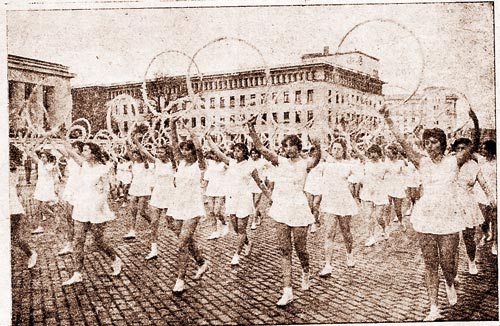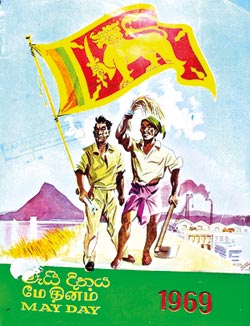Turning back the pages on May Days past

Women’s physical exercise drill, Thozhilali, 1963, May 1. Pic courtesy Noolaham.org
The first May Day or International Workers Day, was commemorated in Sri Lanka in 1927 by A. E. Goonesinghe, who founded the Ceylon Labour Party as well as Sri Lanka’s first trade union, known today as the Ceylon Mercantile Union. The first commemoration in 1927 and the first rally in 1933 took place amidst major labour and independence struggles when Goonesinghe and others launched railway, harbour, hotel, and me-dia strikes for increased wages and better working conditions.
May Day was a way to celebrate workers’ contributions and fight for rights as people would leave work to join the processions.
In 1956 May Day was declared a public, bank and mercantile holiday and since then has been celebrated in Sri Lanka each year though the shape of celebrations has taken different forms depending on the political context.
In the second half of the 21st century, thousands gathered to witness concerts, dance shows, religious sermons, games and rallies organised by unions to mark the day. One image from 1963 shows women participating in a May Day physical training exhibition. Publications preceding May 1 reveal the popularity of celebrations with advertisements by trade unions alerting readers to the time and location of their rallies.

Cover of May Day booklet issued by the Department of Labour in 1969
Newspapers were also full of commentary from politicians and advertisements from businesses with May Day greetings. One tuition centre’s advertisement read: “Sending Revolutionary Greetings to the Workers of the World”. A Finance Company posted well wishes “from your friends in finance”. Flanking the week’s news were poems submitted by readers to commemorate the day. Some poems chronicled the history of labour movements, while others recounted workers’ struggles
and still other verses narrated Marxist theory.
In 1966, Saumiyamoorthy Thondaman, leader of the Ceylon Workers Congress spoke at a rally on the importance of worker participation. “The issues of workers cannot be resolved without the participa-tion of workers,” he said, “workers must speak up and have their views heard, only then will any solution be a worthwhile one.”
In 1989 Wickramabahu Karunaratne, from the Nava Sama Samaja Party said that workers were strug-gling because of high inflation. “The government has crushed the protests of the working class in this regard,” he said, “but all those in opposition must work together to bring victory to the struggle.” He called for an increase to the minimum wage and to government contributions towards pensions.
But not all May Day celebrations transpired without a hitch. In 1972, N. M. Perera, founding member of the Lanka Sama Samaja Party and a trade unionist spoke to the Daily Mirror on the “tragedy” that was the banning of May Day for security reasons following the JVP insurrections of 1971. A newspaper headline recorded “May Day Celebrations on Subdued Note”. That same year Prime Minister Sirimavo Bandaranaike requested workers to support her through difficult economic times, thanking them for rallying during the crises of 1971.
Again in 1987 many leftist parties were banned and May Day celebrations were prohibited. There was tight security on the streets as several unions defied police and organised processions. Meanwhile in LTTE-controlled Jaffna, May Day processions took place with the Uthayan newspaper’s editorial calling for May Day to become an integral part of the Tamil national struggle.
May Day 1993 remains a day seared in the memory of Sri Lankans. President Ranasinghe Premadasa was assassinated by a suicide bomber while leading a UNP May Day procession. “Terror at the May Day Rally”’ read the headlines the next day, detailing the incidents leading up to the assassination. The bombing took place at the Armour Street junction right in front of a police station killing 30 besides President Premadasa and injuring 60 more. The government blamed the LTTE for the massacre and they in turn denied involvement.
Searching for an ideal partner? Find your soul mate on Hitad.lk, Sri Lanka's favourite marriage proposals page. With Hitad.lk matrimonial advertisements you have access to thousands of ads from potential suitors who are looking for someone just like you.


